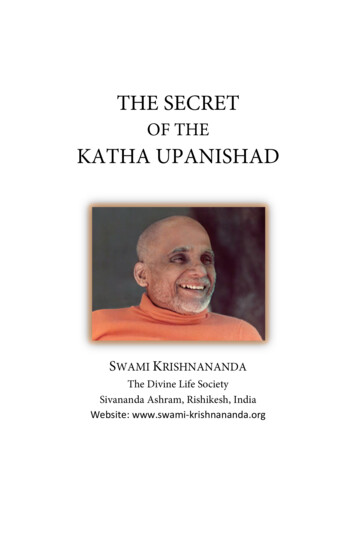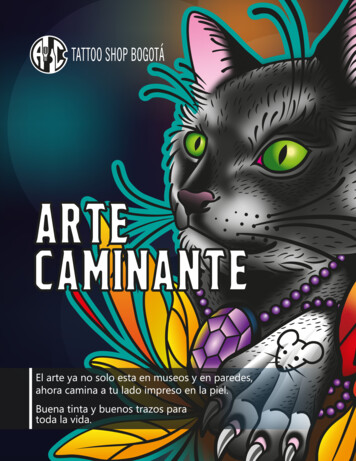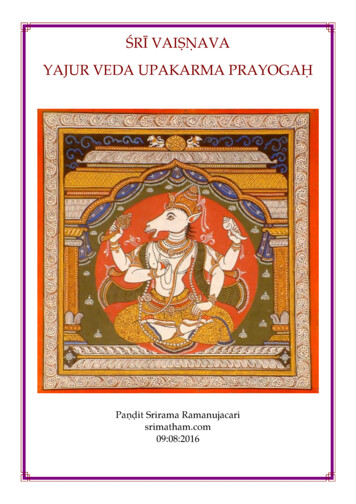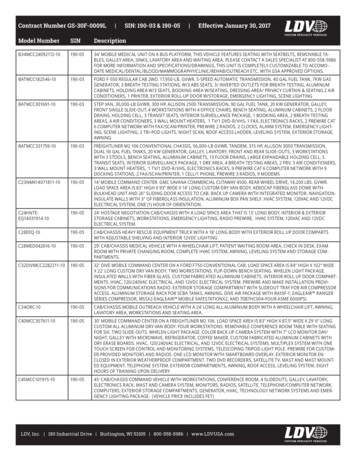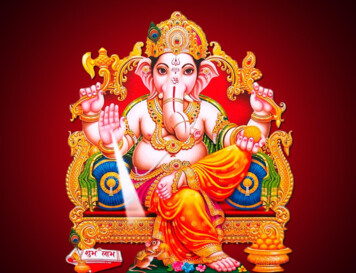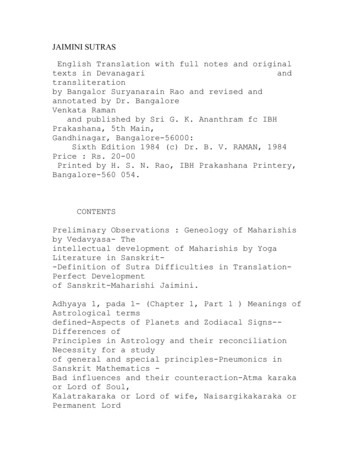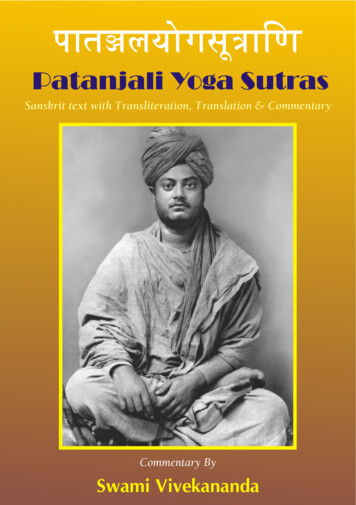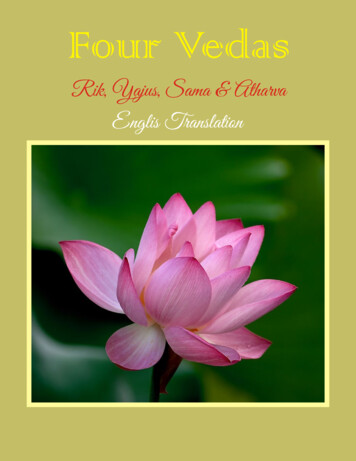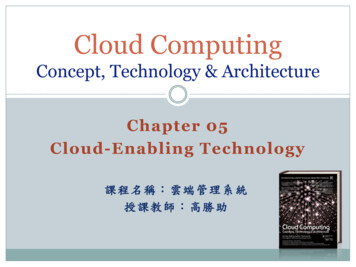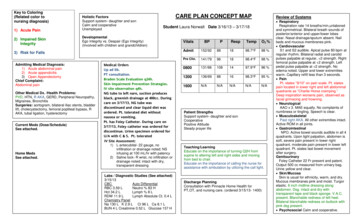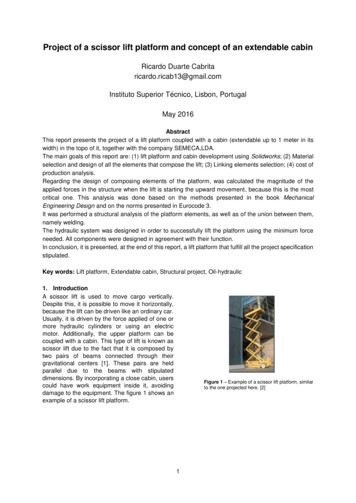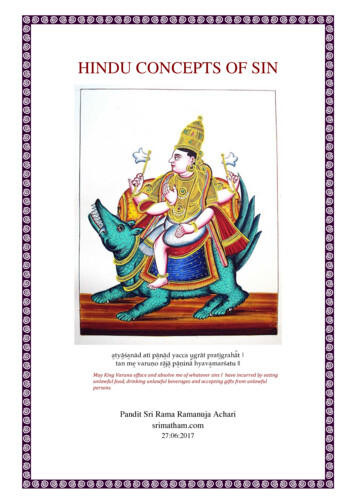
Transcription
HINDU CONCEPTS OF SINa̱tyā̱śa̱nād atī pā̱nā̱d yacca u̱grāt prati̱grahā̎t tan me̱ varuṇo rā̱jā̱ pā̱ṇinā̎ hyava̱marśatu agesandacceptinggiftsfromunlawfulpersons.Pandit Sri Rama Ramanuja Acharisrimatham.com27:06:2017
2HINDU CONCEPTS OF SINIntroductionModern Hinduism has three major sources — (1) the Dharma Śāstras, (2) the Upaṇiṣads(Vedānta) both based upon the Veda collectively called nīti and (3) Rīti — custom and usageof the various castes and communities.Vedānta is the theoretical heart of Hinduism and the Dharma Śāstras the source of commonpractice. The concept of sin is peripheral to the philosophy of Vedānta which hardly eventouches on it, the Dharma Śāstra on the other hand, as legal manuals of practical conduct doesdeal with it in depth.The Vedānta, like all the Indian philosophies, centres on the universal problem of suffering(dukha), it’s causes (avidya or nescience) and it’s eradication. Sin is regarded as unskilfulaction (akuśala karma), which results in further suffering, hinders spiritual practice (sādhana)and retards spiritual progress and reunification with Brahman.The key existential problem of Hinduism is an epistemological one — i.e. spiritualignorance (avidya) which means ignorance of our true natures as modes of Divinity(jivātman) and the mistaken personal identification with our bodies, minds and materialcircumstances (moha). The solution to the problem is self-knowledge — ātma-vidya or ātmajñāna.CHRISTIAN DOCTRINE OF SINIn comparison to Hinduism where sin is peripheral, sin is central to the whole theology of Christianity,everything in Christianity relates to the reality and evil of sin. Without the doctrine of sin, Christianity ceases toexist. Sin is an ontological problem — meaning that sin is the very problem which religion addresses.Sin is anything that is contrary to the law or will of God. If you do what God has forbidden, then you havesinned. In addition, if you do not do what God has commanded, you sin. Either way, the result is eternalseparation from GodOriginal sinAccording to mainstream Christian theology, at the moment the mythological Adam and Eve ate the fruit fromthe tree of knowledge — which God had commanded them not to do — both sin and death were born. Theiryears of life were limited. Since Adam represented the father of the human race, he is held responsible and thusthe Fall of man is referred to as the "sin of Adam", which is inherited from him as a condition of fallen humannature. Satan tempted Eve who then tempted Adam — so Christians believe that the Devil has a significant roleto play in tempting humans to sin.Original Sin is the cause of Adam and all his descendants losing unrestricted access to God:–"Wherefore, as by one man sin entered into the world, and death by sin; and so death passed upon allmen, for that all have sinned."(Rom 5:12)In Christian theology, the sacrifice of Jesus on the cross is the atonement for the sin of Adam."For as in Adam all die, even so in Christ shall all be made alive."(1 Cor 15:22)So every person that is born is born sinful and corrupted by their very nature. The sacrifice of Jesus on the crosswas the remedy. As a result of that act of sacrifice all who put their trust in Jesus and are baptized now haveunrestricted access to God through him.
31. Sin in the VedasIn the Rig Veda we are presented with the vague idea of sin as some kind of an offenceagainst the gods which results in illness, misfortune, drought, conflict etc. The so called 'sins'are not actually detailed, but a number of synonyms are used which gives us a notion of whatthey were on about:—āgas (scandal, offence), agha (impurity, mishap, distress), abhidroha (injury) enas (bad luck),durita (bad course, difficulty), duskṛta (bad deeds), drugdha (hurtful, malicious actions),amhas, urjina, droha (injuring, spiteful, hurtful actions), kilbiṣaḥ (stain, defilement).There are many Sūktas addressed primarily to Varuṇa imploring his forgiveness and towithhold his anger and punishment for the transgressions committed.The Vedic concept of ‘sin’ (anṛtam untruth) is a co-relative of it’s positive polarity — ṛtaṁRitam/ Satyam — refers to the regular order or equilibrium and harmony of the Cosmos,the homeostasis of the Cosmic Person (puruṣa), the "body" of which is the physical universe.Vedānta is pantheism — Brahman is the totality of being, it is the quantum energy of whicheverything is composed.Ritam has three aspects:—1. The regular and general order in the cosmos and the natural laws (adhibhūtam)2. The correct and ordered way of the cult of the gods (yajña)1 (adhidaivatam)3. Ethics, morality and spiritual evolution of humankind (adhyātmam)Our proper response to these three imperatives are encapsulated in the doctrine of the HitaTrayam — the threefold benefit.1. Assisting in the cosmic order by doing the right thing by the environment and ensuringwe live sustainably.2. Ensuring the continued making of offerings and ceremonies for the devas throughyajñas2.3. Living an ethical life creating harmony, stability and peace in society between allsocial orders.2. In the Dharma śāstraThe cosmic struggle in Hinduism as reflected in the Dharma Śāstra and the Purāṇas is notbetween good and evil like the Abrahamic religions but between chaos and order. Sins are asymptom of chaos, a disturbance of social order and harmony based on selfish individualmotivation (svārtha) and not in anyway related to a force of evil (the devil or Satan as inChristianity).In the Dharma Śāstra literature, which is primarily practical and legalistic, we find a shiftaway from the view that ‘sin’ was an offence against the gods to the idea that1yajño vā ṛtasya yoniḥ (S.B.1.3.4.16) Yajña (reciprocal exchange of energy) is the matrix ofRita.2saha yajñaiḥ prajāḥ sṛṣṭvā purovāca prajāpatiḥ anena prasaviṣyadhvam eṣa vo’stviṣṭa kāmadhuk Gītā 3:1010. In the beginning the Lord of all beings, created humans along with the yajña (sacrifice), saying: 'Bythis shall you prosper; this shall be the cow of plenty granting all your desires.'11. By this, may you nurture the gods, and the gods will nurture you [in return]. Thus, nurturing oneanother, you will obtain the highest good
4‘sin/crime/transgression’ was the cause of spiritual, physical, social and ritual pollution3remedied through purificatory rites and penance. Like all ancient literature the Dharma Śāstradoes not differentiate between crime (secular) and sin (religious).Sins, referred to as pāpam or pātakam are divided into categories and enumerated at greatlength. There is a lot of difference of opinion in the Dharma Śāstra about whichsins/transgressions fit into which category. The purpose of categorizing them was to indicatethe type of atonement/penance that was to be prescribed, and about this there is also muchdifference of opinion amongst the law-givers.Transgressions are also gender and class (varna) based, and what is considered as pāpam forone class or gender may not be so for another — e.g. it is a sin for a Brahmin to drink alcoholbut not for a Sūdra. A woman can begin her daily chores without taking a shower whereas itis compulsory for men.It is important also to retain an awareness of historical time difference and avoid applying ourmodern socio-political theories of gender-politics, class-conflict, egalitarianism, socialism,humanism, cultural relativism etc., when judging texts which are 1000 years old! So pleaseview these descriptions and prescriptions in the time frame and social context in which theywere given and then judge whether they are still valid or not. Some of the "sins" enumeratedare quite quaint and quirky to us in the 21st century! What is no longer valid can readily berejected, since in Hinduism they are not the immutable laws of the Creator but ratherlegislation of very human law-givers!Āpastamba divides crimes/sins into two categories viz.1. pataniya (those that result in social impurity and social demotion — i.e. loss of caste).Seeing that the classical caste system is no longer applicable, these acts while they arestill crimes/sins do not result in any social disability.2. aśucikara (those that cause personal impurity, though no social disability).pataniya 3aśucikara4Crimes whereby one becomes an abhiśastaComplete loss (by neglect) of the Vediclearning that one secured by study andmemorization.Grand larcenyDrinking of sura — alcoholic beverages.Causing abortionIncestSexual misconduct — intercourse with thefemale friend of one's female guru (mother etc.)or with the female friend of one's guru (fatheretc.) and with the wife of any stranger.Constant commission of immoral acts(adharma). Cohabitation of a noble womanwith commoners,Cohabitation of noble men withcommoners.Eating the flesh of forbiddenanimals such as that of a dog or ahuman being or village cocks andpigs or other carnivorous animals,Eating the excrement of humanbeingsPartaking of food left over bypersons other than parents orgurus.The technical term for purity is śaucam and impurity aśaucam, derived from the root śuci which meansbright/clear.4abhiśastas, are those who murder a Vedic scholar or one who had been initiated for the performance of asoma sacrifice; one who causes an abortion, or one who kills a menstruating woman. (1.9.24.6-9).
5The Baudhāyana Dharmasūtra (II.1) divides sins into:—pataniya Making voyages by seaStealing the property of apriestMisappropriating a depositGiving false evidenceregarding land (disputes)Trading with merchandiseof all descriptionsServing lower classesBegetting a child on acommonerupa-pātaka Sex with a proscribedfemale.Sex with the female friendof a female guru or withthe female friend of amale guruSex with a female outcast.Practicing medicine.Officiating as a villagepriest.Earning a living throughtheatre and drama.Violating virgins.aśucikara Gambling Engaging in black magic Subsisting by gleaningcorn fallen in the field Subsisting by handoutsafter graduating. Staying for more thanfour months at histeacher's seminary aftergraduation. Practicing astrology as aprofession.Kātyāyana divided sinful acts into five classes viz. mahā-pāpa (mortal sins), ati-pāpa (thehighest sins than which there is nothing worse), pātaka (sins similar to mahā-pātakas),prāsangika (due to association or contact with offenders) and upa-pātaka (minor sins).The Viṣṇu-dharma-sūtra (33.3-5) speaks of nine kinds of transgressions viz. ati-pātaka,mahā-pātaka, anu-pātaka, upa-pātaka, jāti-bhraṁśa-kara (social-expulsion), saṅkari-karaṇa,(drop in social status), apātri-karana (rendering the perpetrator unworthy of receiving gifts),mala-vāha (causing defilement) and prakīrṇaka (miscellaneous).Manu-smriti omits the separate mention of ati-pātaka and anu-pataka and includes most ofthem under those that he designates as equal to one of the four well-known mahā-pātakas.3. The Mahā-pātakasThe Pañca Mahā-pātakas or ‘Five Great Sins’ are the framework for much of the Hindudiscourse on the subject of sin. These are five broad headings and not specific acts per se.Usually the five mahā-pātaka have been enumerated from the days of the ChāndogyaUpaṇiṣad and throughout all the Dharma Shastras as:—(1) Brahma-hatyā — heinous murder.(2) Surā-pāna — drinking the spirituous liquor.(3) Suvarṇa-steya — theft of gold.(4) Guru-talpaga — sexual intercourse with the wife of a guru.(5) Saṁsarga — association with the perpetrators of any of these four (for a year ormore). Some texts substitute infanticide or abortion instead of samsarga.What constitutes a crime as differentiated from sin has changed over time with the evolutionof the modern legal system. Adultery and homosexuality for example in English andReligious Canon law were crimes until quite recently. In modern western society bothadultery and homosexuality are no longer crimes but are still considered as ‘sins’ according to(Christian) Canon Law.In Hinduism, murder, theft and certain sexual misconduct such as rape, incest and pedophiliaare crimes as well as being sins, but drinking alcohol while not a crime is considered to be asin for some (priests) and not for others (commoners). Continued and regular association withthese miscreants is not a crime but is considered to be corrupting or ‘polluting’.
6Both the secular law and the ecclesiastical laws make a difference between a sinful actintentionally committed (kāmataḥ) and one committed through ignorance or heedlessness(ajñānataḥ) and between an act done only once (sakṛt) or done repeatedly (asakṛt).In the case of the three social orders other than that of the priests, some smrtis like that ofCyavana laid down other mahā-pātakas in addition to the five, viz. for the ruling class — punishing an innocent person and fleeing from the battle-field.for the business community — using false balances and weights and cheating ingeneral.for the working class — engaging in the meat trade, causing harm to a priest.All Hindu Canon law (not being a revelation from an omniscient god) is subject toconsiderations of time, place and circumstance, so while retaining the categories of the Mahāpātakas we are at liberty in the modern world to modify and adapt them to contemporarysocial circumstances and mores.1. Brahma-hatyā — Heinous MurderThe literal meaning is brahma enormous, great, heinous; hatya murder.Brahma-hatyā, or vadha (killing) is defined as:— “an act which immediately or after sometime results in the loss of life directly without the intervention of any other cause”.The primary meaning given by the lawyers is the premeditated murder of a learned priest.5But refers more to the extreme gravity of the crime rather than the specific act of murdering amember of the brāhmin caste. In the days before mass media all knowledge was learned byrote and carried in the heads of the priests. Killing a learned priest was therefore likedestroying a library of precious books before the a
The Pañca Mahā-pātakas or ‘Five Great Sins’ are the framework for much of the Hindu discourse on the subject of sin. These are five broad headings and not specific acts per se. Usually the five mahā-pātaka have been enumerated from the days of the Chāndogya
